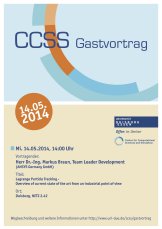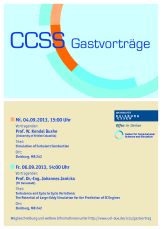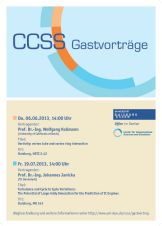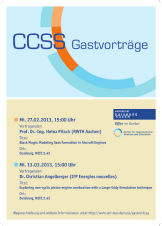CCSS Gastvorträge
CCSS Gastvortrag (Januar 2015)
Mittwoch, 14. Januar 2015, 14:00 Uhr:
Prof. Markus Klein (Universität der Bundeswehr München):
Analysis of the Combined Modelling of Subgrid Transport and Filtered Flame Propagation for Premixed Turbulent Combustion
Abstract:
Flame surface density (FSD) based reaction rate closure is an important methodology of turbulent premixed flame modelling in the context of Large Eddy Simulations (LES). The transport equation for the Favre-filtered reaction progress variable needs closure of the filtered flame front displacement (FFFD) term (i.e. filtered value of combined reaction rate and molecular diffusion rate) and the sub-grid scalar flux (SGSF). A-priori analysis of each individual term has in the past revealed advantages and disadvantages of the specific modelling attempts. Some recent results will be summarized. However, for a successful modelling of the transport equation it is important to understand the interaction of the FFFD and SGSF closures, and it is not known a-priori if the combination of the best SGSF model with the best FFFD model results in the most suitable overall modelling strategy. In order to address this question in this work a variety of SGSF models is analysed together with one well established and one more recent FFFD closure based on a-priori analysis. Focal point is the assessment of the new FFFD closure and in particular of the overall modelling strategy. It is found that the success of the combined FFFD and SGSF closures depends on subtle details like the co-variances of FFFD and SGSF terms. As an example the gradient hypothesis model is not very successful in representing SGSF. However in combination with the FFFD term the gradient hypothesis yields the best combination in one of the recently proposed FFFD closures, whereas the worst result is obtained for another existing closure, which was shown to predict the FFFD term satisfactorily in several previous analyses.
Duisburg, NETZ-Gebäude, NETZ 2.42 (Anfahrt)
CCSS Gastvorträge (September/Oktober 2014)
Freitag, 19. September 2014, 14:00 Uhr:
Prof. Bisetti (KAUST, Saudi-Arabia):
Unraveling the evolution of aerosols in turbulent flows via massively parallel simulations
Short bio:
Fabrizio Bisetti is an Assistant Professor in Mechanical Engineering at King Abdullah University of Science and Technology, where he joined the Clean Combustion Research Center in July 2009.
Prof. Bisetti holds a Laurea (Politecnico di Milano, 6/2003), MS (UT Austin, 8/2002), and PhD (UC Berkeley, 12/2007) in Mechanical Engineering. Upon graduation, he joined the Center for Turbulence Research at Stanford University as a Postdoctoral Fellow (1/2008-6/2009).
Prof. Bisetti’s research interests are in soot formation in turbulent flames, turbulent aerosols, turbulent mixing, ion and electron chemistry and transport in flames, and numerical methods for reactive flows. At KAUST, his research activities combine High Performance Computing (HPC) and experimental studies to understand complex multi-physics/multi-scale processes in turbulent flows (e.g. aerosol/turbulence interaction). For more information, visit http://flow.kaust.edu.sa.
Abstract:
Aerosols are ubiquitous in nature and industrial flows. The physical properties of aerosols are strongly affected by the history of temperatures and concentrations experienced by the particles during formation and growth. This sensitivity results in an important dependence of aerosols' properties from mixing in turbulent flows.
From an industrial perspective, the design of efficient reactors and the control of the particles' size distribution are of paramount importance and point to the need for a more fundamental understanding of the interaction between turbulent mixing and the aerosols’ microphysical processes.
In this talk, I will present our recent work on the simulation of the formation and growth of aerosols in canonical turbulent flow configurations of practical interest. I will focus on three closely-related topics: soot formation in turbulent flames, the evolution of condensation aerosols in mixing layers, and the simulation of the size distribution of soot aggregates in stochastic reactors.
Those large databases are invaluable as they give novel insight into the most relevant processes and provide concurrent and space-& time-resolved information on gas-phase scalars and aerosol quantities such as number density, volume fraction, and particle sizes. It is envisioned that our results will aid the development of closure models for large-eddy simulation of soot formation in combustors and of powder production in industrial-scale reactors.
Donnerstag, 09. Oktober 2014, 10:30 Uhr:
Dr. Stein (ITV Universität Stuttgart):
Transient numerical simulations of reacting gas- and particulate-flows
Abstract:
The talk will present the latest research activities at the Institute for Combustion Technology (ITV) at the University of Stuttgart. First, an overview of ITV's research will be given and a summary of ongoing work using Monte-Carlo simulations to model nano-particle formation and -growth will be provided. The main focus of the presentation will be solid fuel combustion. Here, work on direct numerical simulations of single coal particle ignition and combustion for advanced flamelet modelling will be presented. The talk will close with current results from the large eddy simulation of pulverised coal combustion on the lab and pilot scale.
Duisburg, NETZ-Gebäude, NETZ 2.42 (Anfahrt)

CCSS Gastvortrag (Mai 2014)
Mittwoch, 14. Mai 2014, 14:00 Uhr:
Dr.-Ing. Markus Braun (Team Leader Development, ANSYS Germany GmbH):
Lagrange Particle Tracking - Overview of current state of the art from an industrial point of view
Duisburg, NETZ-Gebäude, NETZ 2.42 (Anfahrt)

CCSS Gastvorträge (September 2013)
!! Achtung: Raumänderung (siehe unten)!!
Mittwoch, 04. September 2013, 15:00 Uhr:
Prof. W. Kendal Bushe (University of British Columbia):
Simulation of Turbulent Combustion
Short bio:
W. Kendal Bushe graduated in Mechanical Engineering from the University of Alberta in 1992. He went to Cambridge University to obtain his PhD, then took a post-doctoral research fellowship with the Center for Turbulence Research at Stanford University and NASA's Ames Research Center. He has been a Professor at the University of British Columbia since 1999 where he has been working on clean energy-related research, including in engines and gas-turbines. His work primarily focuses on the numerical simulation of turbulent reacting flows.
Abstract:
Modern energy conversion devices such as gas turbines/jet engines, internal combustion engines for cars, trucks and district energy systems have evolved over many decades. Their performance must be improved further to meet future needs, particularly with respect to fuel efficiency and pollutant emissions, and there are clear opportunities to improve existing designs. To realize these, the fundamental transport and combustion processes need to be carefully taken into account in the design process, which necessitates detailed numerical simulation. The challenges of simulating turbulent combustion processes are many. Simulating turbulence is itself particularly difficult because turbulent flows exhibit a vast range of length- and time-scales that either need to be resolved on one's computational grid or modeled in some way. Adding the complexity of chemical reactions to the system adds many more time-scales and this can make the problem almost intractable. This talk will describe the problem in brief, then discuss some solutions, starting with addressing first the need for improved chemical kinetic mechanisms, then the need to reduce their complexity to make them compatible with simulations of turbulent flows. Finally, the need to account for the complex interactions between turbulence and chemical reaction will be discussed and results of simulations will be compared to experimental data.
Freitag, 06. September 2013, 14:00 Uhr:
Prof. Dr.-Ing. Johannes Janicka (TU Darmstadt):
Turbulence and Cycle to Cycle Variations: The Potential of Large-Eddy Simulation for the Prediction of IC Engines
Inhalt des Vortrags
- Motivation and Objectives
- The Darmstadt IC-engine
- Models and numerical setup
- LES of motored IC-engine operation
- Verification and validation
- Understanding some basic mechanisms of two phase flows
- Perspective and conclusion
Duisburg, MB 242 (Anfahrt)

CCSS Gastvorträge (Juni/Juli 2013)
Donnerstag, 06. Juni 2013, 14:00 Uhr:
Prof. Dr.-Ing. Wolfgang Kollmann (University of California at Davis):
Vorticity: vortex tube and vortex ring interaction
Duisburg, NETZ-Gebäude, NETZ 2.42 (Anfahrt)
Freitag, 19. Juli 2013, 14:00 Uhr:
Prof. Dr.-Ing. Johannes Janicka (TU Darmstadt):
Turbulence and Cycle to Cycle Variations: The Potential of Large-Eddy Simulation for the Prediction of IC Engines
!! Achtung: Vortrag wird verschoben auf den 06. September 2013 (siehe oben) !!

CCSS Gastvorträge (Februar/März 2013)
Mittwoch, 27. Februar 2013, 15:00 Uhr:
Prof. Dr.-Ing. Heinz Pitsch (RWTH Aachen):
Black Magic: Modeling Soot Formation in Aircraft Engines
Mittwoch, 13. März 2013, 15:00 Uhr:
Dr. Christian Angelberger (IFP Energies nouvelles):
Exploring non-cyclic piston engine combustion with a Large-Eddy Simulation technique
Abstract:
Duisburg, NETZ-Gebäude, NETZ 2.42 (Anfahrt)
